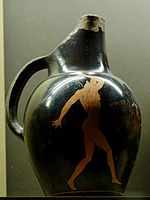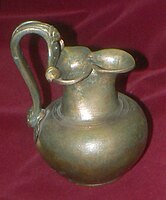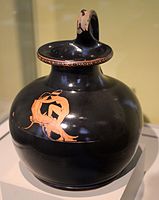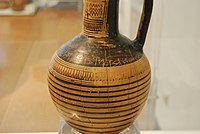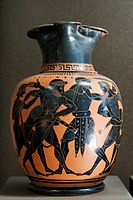Oenochoe

An oenochoe, also spelled oinochoe (Template:Lang-grc; from Template:Lang-grc oînos, "wine" and Template:Lang-grc khéō, "I pour"; plural oenochoai or oinochoai), is a wine jug and a key form of ancient Greek pottery. There are many different forms of oenochoe; Sir John Beazley distinguished ten types. The earliest is the olpe (ὀλπή, olpḗ), with no distinct shoulder and usually a handle rising above the lip. The "type 8 oenochoe" is what one would call a mug, with no single pouring point and a slightly curved profile. The chous (χοῦς; pl. choes) was a squat rounded form, with trefoil mouth. Small examples with scenes of children, as in the example illustrated, were placed in the graves of children.[1]
Oenochoai may be decorated or undecorated.[2] Oenochoai typically have only one handle at the back and may include a trefoil mouth and pouring spout. Their size also varies considerably; most, at up to 25 cm tall, could be comfortably held and poured with one hand, but there are much larger examples.
Most Greek oenochoe were in painted terracotta pottery but metal oenochoai were probably also common among the better off, though as with other vessel shapes, few have survived.[3] Again as with other shapes, large versions in stone were sometimes used as grave markers, often carved with reliefs. In pottery, some oinochoai are "plastic", with the body formed as sculpture, usually one or more human heads.
-
Oinochoe Shape 1, H. 22 cm (8 ½ inches), diam. 13.5 cm (5 ¼ in.), Eos (Dawn) pursuing Tithonus. Attic red-figure, 470–460 BC
-
Oinochoe Shape 2, H. 23.5 cm (9 ¼ in.), diam. 14.3 cm (5 ½ in.), Attic, 4th century
-
Oinochoe Shape 3, H. 10.5 cm (4 in.); Diam. 8.1 cm (3 in.)
-
Oinochoe Shape 7, H. 21 cm (8 ¼ in.), diam. 12.8 cm (5 in.), Javelin thrower. Attic red-figured, ca. 450 BC
-
Shape 8, 8th century BC
-
Olpe, Corinthian, c. 575–c. 550 BC, height: 25.2 cm (9.9 in). Diameter: 13.1 cm (5.2 in)
-
Chous, last decade of the 5th century BC, 9.1 × 7 cm (3.6 × 2.8 in). Probably used in a child's grave.
-
Plastic version with woman's head
-
Funerary oinochoe, with "farewell" scene with a deceased woman, third quarter of the 4th century BC
-
Bronze oenochoe, Nova Zagora, Bulgaria, with a trefoil spout
-
Archaic period, 750–600 BC
-
Oinochoe by the Shuvalov Painter (Berlin F2414) with famous erotic scene
-
The Dipylon Inscription, c. 740 BC, perhaps the earliest datable Greek writing
-
Squat oinochoe, with ibex and lions, Otterlo Painter, late 7th c BC
-
Apulian red-figure Oinochoe by the White Saccos Workshop
-
Dispute between Ajax and Odysseus for Achilles' armour. Attic black-figure oinochoe, ca. 520 BC. Kalos inscription. H. 20 cm (7 ¾ in.), diam. 13.7 cm (5 ¼ in.)
See also
- Typology of Greek vase shapes
- Corpus vasorum antiquorum
- Ancient Greek vase painting
- Pottery of ancient Greece
References
- ^ Beazley Archive, Oxford University, "Oinochoe, olpe and chous"
- ^ Woodford, S. (1986). An Introduction to Greek Art. London: Duckworth, p. 12. ISBN 0-7156-2095-9
- ^ Silver 'oinochoe' from the "Tomb of Philip" at Vergina, accessdate=2015-06-24
External links
 Media related to Oinochoes at Wikimedia Commons
Media related to Oinochoes at Wikimedia Commons




